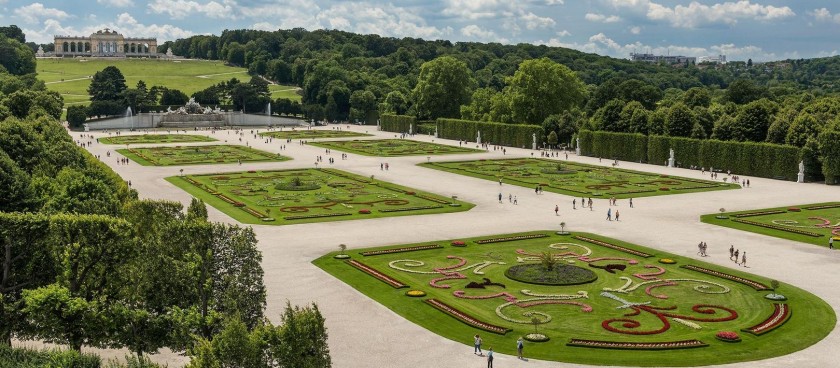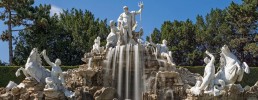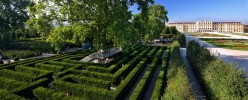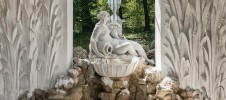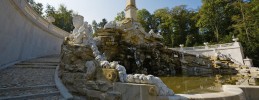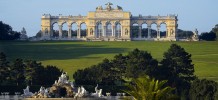- #AT04
- Schloß Schönbrunn 1130 Vienna, Austria
- +43181113-0
- info@schoenbrunn.at
- https://www.schoenbrunn.at/en/about-s...
- Working hours*:
28 October 2018 - 24 February 2019
6:30 - 17:30
25 February - 31 March 2019
6:30 - 19:00
1 April - 30 April 2019
6:30 - 20:00
1 May - 31 July 2019
6:30 - 21:00
1 August - 31 August 2019
6:30 - 20:00
1 September - 31 October 2019
6:30 - 19:00 - Prices*:
Privy Garden
Adults - 4,50€
Children (aged 6 - 18) - 3,20€
Students (aged 19 - 25) - 3,50€
Disabled people - 3,50€ - * - opening and closing times as well as entrance prices, are subject to alterations without notice. Visitors are advised to check before visiting.
- 48.1837550, 16.3113570 Copy to clipboard Copy
-
#Family time , #Parks
The park at Schönbrunn Palace was opened to the public around 1779 and since then has provided a popular recreational amenity for the Viennese population as well as being a focus of great cultural and historical interest for international visitors. Extending for 1.2 km from east to west and approximately one kilometre from north to south, it was placed together with the palace on the UNESCO list of World Heritage Sites in 1996.
The Great Parterre - The largest open space in the gardens
Extending in front of the south-facing side of the palace, the Parterre with its strictly symmetrical beds occupied the largest open space in the gardens. In the middle of the eighteenth century the beds consisted of formal patterns made with strips of box hedging on coloured gravel or sand, and were known as ‘broderie’ parterres since these motifs were mostly taken from embroidery patterns.
At this time the two larger sections of parterre towards the south enclosed so-called ‘boulingrins’, a term derived from the English ‘bowling green’, a sunken lawn intended for games of bowls but which in French horticultural design were used exclusively as decorative elements.
To either side of the parterre were boskets or formal plantings of severely clipped hedges forming passageways, small openings and hidden enclosures.
Statues in the Great Parterre
This Baroque design probably derives from the Lotharingian architects in the circle of Emperor Franz I Stephan. In the 1770s it was superseded by the present design to plans by the architect Johann Ferdinand Hetzendorf von Hohenberg, with beds planted with flowers, and tall hedges on either side lined with rows of marble statues, most of them executed by Christian Wilhelm Beyer.
Maze
The Maze at Schönbrunn was laid out around 1720 and originally had four quadrants with a central (probably elevated) pavilion. Consisting of paths between tall, narrow hedges without the dead-ends and false turns of a classic maze, it was intended to offer an inviting setting for a gentle stroll.
It was gradually abandoned and eventually cleared in 1892. 1999 saw the opening of the new Maze: extending over 1,715 m², it was reconstructed on the historical model with yew hedges.
At its centre again is a viewing platform, next to which two harmony stones with ‘energizing properties’ have been set up.
Labyrinth
Reconstructed according to the original historical designs, the Labyrinth invites you to come and discover its secrets. Extending over an area of 2,700m², it offers plenty of games for visitors of all ages.
For example, using your fingers to solve mazes or hopping your way across bouncing boards. A giant kaleidoscope lets you see yourself from every possible and impossible angle. Athletic visitors can climb a ‘chiming climbing pole’ and ring the bell at the top.
For people who like a mental challenge there’s a mathematical riddle: numbers on stepping stones tell you how many steps you’re allowed to take – by the end you should find yourself right in the middle of the game.
And there’s a more complicated version for maths wizards! The Labyrinth is a playful place for visitors of all ages to relax and have fun.
Labyrinthikon Playground
Another highlight is the Labyrinthikon, designed by playground design expert Günter Beltzig: a playground of experimentation and fun for all generations.
Neptune Fountain
Designed as the crowning element of the Great Parterre, and sited at the foot of the hill behind the palace is the Neptune Fountain, which was conceived as part of the overall design of the gardens and park commissioned by Maria Theresa in the 1770s.
Under the direction of court architect Johann Ferdinand Hetzendorf von Hohenberg, excavations for the basin were started in 1776, and work was completed four years later, just before the death of the empress. It was very probably designed by Hetzendorf von Hohenberg, while the sculptural group of Sterzing marble was executed by Wilhelm Beyer.
A retaining wall curving back into the slope of the hill, its balustrade crowned with vases, forms the back wall of the vast basin.
At the centre the wall is interrupted by a projecting, semi-oval plinth from which rises a rocky landscape peopled with the sea-god Neptune and his entourage.
Retaining wall and plinth are articulated by blind panels, those on the plinth being decorated with masks, while the vertical elements separating them are embellished with garlands.
At the centre of the figural group above a rocky grotto stands Neptune in a shell-shaped chariot, his trident in his hand. To his left is a nymph, while on his right kneels the sea-goddess Thetis,
entreating Neptune to favour the voyage of her son, Achilles, who has set off to conquer Troy. Frolicking at the foot of the grotto are the Tritons, creatures who are half-man and half-fish, and belong to Neptune’s entourage.
They hold conch shell trumpets with which they can inspire fear in both man and beast, and are restraining the hippocampi or sea-horses who draw Neptune’s chariot across the seas.
Neptune driving across the seas in dominion over the watery element is a common motif in sixteenth- to eighteenth-century art, being used as a symbol for monarchs controlling the destiny of their nations.
The figural group was originally free-standing, but a screen of trees was planted behind it during the nineteenth century in order to provide it with an effective foil.
